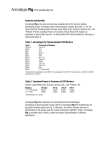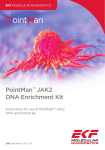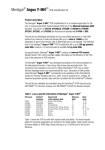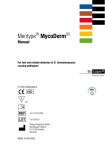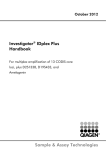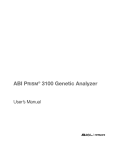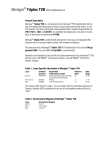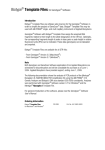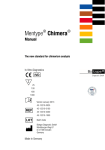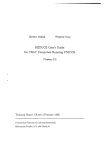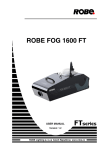Download Mentype Argus X-12_engl
Transcript
Mentype® Argus X-12 PCR Amplification Kit
Product description
The Mentype® Argus X-12 PCR Amplification Kit is a multiplex application for twelve
X-chromosomal Short Tandem Repeat (STR) loci that supplements the Mentype®
Argus Y-MHQS and Mentype® Argus Y-12QS test kit for kinship and paternity testing
especially in complicated deficiency cases. Furthermore the use of gonosomal STRs for
the analysis of DNA traces in the forensic field is strongly rising.
The Mentype® Argus X-12 contains the primers of Amelogenin (AM) for genderdetermination, DXS7132, DXS7423, DXS8378, DXS10074, DXS10079, DXS10101,
DXS10103, DXS10134, DXS10135, DXS10146, DXS10148 and HPRTB. Three
markers belong to one of the four coupling groups of the X-chromosome (Fig. 1), so
that three markers of each group have to be handled as haplotype for genotyping.
The primers are fluorescence-labelled with 6-FAM, BTG, BTR and BTY.
Primer sequences of the Mentype® Argus X-12 are different to that of the Mentype®
Argus X-8 in order to avoid allelic overlapping. Furthermore, the changing results in
more robustness and sensitivity. Because of the new primer design for the locus
HPRTB a dinucleotide-deletion (AG) 48-49 bp downstream of the repeat unit (Mertens
et al. 1999, Gomes et al. 2007) will not be detected any more so that just the real
repeat units will be shown. If necessary point alleles (like 11.2, 12.2), that were
detected by the primers of the Mentype® Argus X-8 or Argus X-UL, should be
rounded up the next full allele for comparing the results generated with the Mentype®
Argus X-12 primers.
The detection limit of the Mentype® Argus X-12 PCR Amplification Kit is 100 pg
genomic DNA. The optimal range under standard conditions is 0.2-0.5 ng DNA.
However, internal validations demonstrated reliable results with <0.1 ng DNA.
The Forensic ChrX Research Group initiated the online data base ChrX-STR.org
(http://www.chrx-str.org) that calculates population-genetic data on basis of
X-chromosmal allele frequencies (Szibor et al., 2006). Additionally, all important
population-genetic data can be calculated with the GenoProof® software.
The test kit was validated and evaluated using the GeneAmp® 9700 thermal cycler,
ABI PRISM® 310 Genetic Analyzer, and ABI PRISM® 3100/3130 Genetic Analyzer.
2
Amelogenin X
DXS10148
DXS10135
DXS8378
DXS7132
DXS10079
DXS10074
9 Mb
linkage group 1
66 Mb
linkage group 2
linkage group 3
DXS10103
HPRTB
DXS10101
DXS10146
DXS10134
DXS7423
133 Mb
149 Mb
linkage group 4
Fig. 1 The ideogram of the X-chromosome describes the physical localisation of the STR loci which can be
analysed with Mentype® Argus X-12. Distances from the p-telomere are shown in Mb
(http://www.ncbi.nlm.nih.gov/genome/guide/human as at 10/2009).
Mentype® Argus X-12
October 2009
3
Content
1. Description of Mentype® Argus X-12...............................................................4
2. PCR amplification...........................................................................................7
2.1 Master mix preparation ............................................................................7
2.2 PCR amplification parameter ....................................................................8
3. Electrophoresis using the ABI PRISM® 310 Genetic Analyzer ............................9
3.1 Matrix generation.....................................................................................9
3.2 Sample preparation................................................................................12
3.3 Setting up the GeneScan® software ........................................................12
3.4 Analysis parameter ................................................................................13
4. Electrophoresis using the ABI PRISM® 3100-Avant/3100 Genetic Analyzer .....14
4.1 Spectral calibration / matrix generation ...................................................14
4.2 Sample preparation................................................................................16
4.3 Setting up the GeneScan® software ........................................................17
4.4 Analysis parameter ................................................................................18
5. Electrophoresis using the ABI PRISM® 3130/3130xl Genetic Analyzer.............19
5.1 Spectral calibration / matrix generation ...................................................19
5.2 Sample preparation................................................................................22
5.3 Setting up the GeneMapper™ ID software ..............................................23
5.4 Analysis parameter / analysis method .....................................................25
6. Analysis.......................................................................................................26
6.1 Biotype® template files...........................................................................27
6.2 Controls ................................................................................................28
6.3 Lengths of fragments and alleles ............................................................28
7. Interpretation of results ................................................................................35
8. Usage of the X-chromosomal STRs and their characteristics ...........................36
9. References ..................................................................................................39
Mentype® Argus X-12
October 2009
4
1. Description of Mentype® Argus X-12
Table 1. Locus-specific information of Mentype® Argus X-12
Amelogenin X
Amelogenin Y
DXS7132
DXS7423
DXS8378
DXS10074
DXS10079
GenBank®
accession
M55418
M55419
G08111
AC109994
G08098
AL356358
AL049564
DXS10101
AC004383
DXS10103
BV680555
DXS10134
AL034384
DXS10135
DXS10146
AC003684
AL034384
DXS10148
AC003684
HPRTB*
M26434
Locus
Repeat motif
of the reference allele
Reference
allele
[TCTA]13
[TCCA]3 TCTGTCCT [TCCA]12
[CTAT]12
[AAGA]14
[AGAG]3 TGAAAGAG [AGAA]17
AGAG [AGAA]3
[AAAG]3 GAAAGAAG [GAAA]3 A
[GAAA]4 AAGA [AAAG]5 AAAAAGAA
[AAAG]13 AA
[TAGA]2 CTGA
[CAGA][TAGA]11[CAGA]4[TAGA]
[GAAA]3 GAGA [GAAA]4 AA [GAAA]
GAGA [GAAA]4 GAGA [GACAGA]3
[GAAA] GTAA [GAAA]3 AAA
[GAAA]4 AAA [GAAA]15
[AAGA]3 GAAAG [GAAA]20
[TTCC]3 T [TTCC]3 TTTC
CTCCCTTCC [TTCC] [TCCC]
TTCTTCTTTC [TTCC]2 TTTCTT
[CTTT]2 CTTC [CTTT]10 T [CTTT]2
[GGAA]4[AAGA]12[AAAG]4 N8
[AAGG]2
[AGAT]12
Allele
range
13
15
12
14
21
8-20
8-19
7-15
4-21
14-25
28.2
24-38
19
15-21
35
28-46.1
23
26
13-39.2
24-46.2
22
13.3-38.1
12
6-19
*[AGAT] is the common repeat structure, for variations see NIST and Szibor et al. 2009.
Table 1 shows the STR loci with their repeat motifs and alleles that are concordant with
the International Society for Forensic Genetics (ISFG) guidelines for the use of
microsatellite markers (Bär et al., 1997). Allele ranges include all known alleles of the
current literature as at 10/2009.
Table 2. Chromosomal mapping of Mentype® Argus X-12
Locus
Amelogenin X
Amelogenin Y
DXS7132
DXS7423
DXS8378
DXS10074
DXS10079
DXS10101
DXS10103
DXS10134
DXS10135
DXS10146
DXS10148
HPRTB
Chromosomal mapping
Xp22.1-22.3
Yp11.2
Xq11.2
Xq28
Xp22.31
Xq12
Xq12
Xq26.2
Xq26.2
Xq28
Xp22.31
Xq28
Xp22.31
Xq26.2
Mentype® Argus X-12
October 2009
5
Content
Mentype® Argus X-12 PCR Amplification Kit (100 reactions)
Nuclease-free water
Reaction mix A
Primer mix
Control DNA XX28 (2 ng/µL)
DNA Size Standard 550 (BTO)
Allelic ladder
3.0 mL
500 µL
250 µL
10 µL
50 µL
25 µL
Ordering information
Mentype® Argus X-12
Mentype® Argus X-12
Mentype® Argus X-12
25
100
400
Reactions
Reactions
Reactions
Cat. No.
Cat. No.
Cat. No.
43-13110-0025
43-13110-0100
43-13110-0400
Storage
Store all components at –20°C and avoid repeated thawing and freezing. Primer mix
and allelic ladder must be stored protected from light. The DNA samples and post-PCR
reagents (allelic ladder and DNA Size Standard) should be stored separately from the
PCR reagents. The expiry date is indicated on the kit cover.
Additionally required reagents
Additional reagents are needed in order to use the Biotype® PCR Amplification Kit:
Reagent
JumpStart™ Taq DNA Polymerase
hot start, 2.5 U/µL, 50 U or 250 U
Hi-Di™ Formamide, 25 mL
Matrix Standards BT5
single-capillary instruments (25µl)
Matrix Standards BT5
ABI multi-capillary instruments (25µl)
Matrix Standards BT5
multi-capillary instruments (50µl)
Mentype® Argus X-12
Supplier
Order number
Sigma-Aldrich
D4184
Applied Biosystems
4311320
Biotype AG
00-10411-0025
Biotype AG
00-10421-0025
Biotype AG
00-10421-0050
October 2009
6
Warnings and safety instructions
The PCR Amplification Kit contains the following potentially hazardous chemicals:
Kit component
Primer mix, reaction mix
and allelic ladder
Chemical
Sodium azide NaN3
Hazards
Very toxic if swallowed, develops toxic
gases when it gets in contact with acids
Observe the Material Safety Data Sheets (MSDS) for all Biotype® products, which are
available on request. Please contact the respective manufacturers for copies of the
MSDS for any additionally needed reagents.
Quality assurance
All kit components undergo an intensive quality assurance process at Biotype AG. The
quality of the test kits is permanently monitored in order to ensure unrestricted
usability. If you have any questions regarding quality assurance, please do not hesitate
to contact us.
Trademarks and patents
Mentype® is a registered trademark of Biotype AG.
GenoProof® is a registered trademark of Qualitype AG.
JumpStart™ is a registered trademark of Sigma-Aldrich.
ABI PRISM®, GeneScan®, Genotyper®, GeneMapper™ and Applied Biosystems are
registered trademarks of Applied Biosystems Inc. or its subsidiaries in the U.S. and
certain other countries.
6-FAM, POP-4 and Hi-Di are trademarks of Applied Biosystems Inc.
GeneAmp® is a registered trademark of Roche Molecular Systems.
The PCR is covered by patents. Patentees are Hoffmann-La Roche Inc. and
F. Hoffmann-La Roche (Roche).
GenBank® is a trademark of National Institute of Health.
Mentype® Argus X-12
October 2009
7
Protocols for PCR amplification, electrophoresis and analysis
2. PCR amplification
2.1 Master mix preparation
The table below shows the volumes of all PCR reagents per 25 µL reaction volume,
including a sample volume of 1.0 µL (template DNA). The number of reactions to be
set up shall be determined taking into account positive and negative control reactions.
Add one or two reactions to this number to compensate the pipetting error.
Component
Nuclease-free water
Reaction mix A*
Primer mix
Taq DNA Polymerase (hot start, 2.5 U/µL)
Volume of master mix
Volume
15.9 µL
5.0 µL
2.5 µL
0.6 µL
24.0 µL
* contains Mg2+, dNTPs, BSA
All components should be mixed (vortex) and centrifuged for about 10 s before
preparing the master mix. The DNA volume applied to the assay depends on its
concentration. A volume of up to 5 µL may be necessary for DNA trace templates. DNA
volumes of more than 5 µL are not recommended, because potential PCR inhibitors
may interfere with the process. Fill up the final reaction volume to 25 µL with
nuclease-free water.
Generally, DNA templates shall be stored in nuclease-free water or in diluted TE buffer
(10 mM Tris HCl, pH 8.0 and 1 mM EDTA), e.g. 0.1x TE buffer.
The primer mixes are adjusted for balanced peak heights at 30 PCR cycles and
0.35 ng Control DNA XX28 in a reaction volume of 25 µL. If more DNA template is
introduced, higher peaks can be expected for small PCR fragments and relatively low
peaks for large fragments. Reduce the amount of DNA template to correct this
imbalance.
Positive control
For the positive amplification control, dilute the Control DNA XX28 to 0.35 ng in the
appropriate volume. Instead of the template DNA, pipette the diluted Control DNA into a
reaction tube containing the PCR master mix.
Negative control
For the negative amplification control, pipette nuclease-free water instead of template
DNA into a reaction tube which contains the PCR master mix.
Template DNA
Sometimes, the measured value of the DNA concentration varies depending on the
used quantification method, so that it may necessary to adjust the optimal DNA
amount.
Mentype® Argus X-12
October 2009
8
2.2 PCR amplification parameter
Perform a “hot start” PCR in order to activate the Taq DNA Polymerase and to prevent
the formation of non-specific amplification products.
The number of cycles depends on the amount of DNA. 30 cycles are recommended for
all samples. For critical stains (< 100 pg DNA), it is recommended to increase the
number of PCR cycles to 32 cycles, i.e. from 25 to 27 in the second PCR step.
Standard method
Recommended for all DNA samples
Temperature
94°C
96°C
63°C
72°C
94°C
60°C
72°C
68°C
10°C
Time
4 min (hot start for activation of the JumpStart™ Taq DNA Polymerase)
30 s
5 cycles
120 s
75 s
30 s
25 cycles
120 s
75 s
60 min
∞
hold
Optional
Recommended for stains with small amounts of DNA
Temperature
94°C
96°C
63°C
72°C
94°C
60°C
72°C
68°C
10°C
Time
4 min (hot start for activation of the JumpStart™ Taq DNA Polymerase)
30 s
5 cycles
120 s
75 s
30 s
27 cycles
120 s
75 s
60 min
∞
hold
Too small amounts of DNA may result in allelic dropouts and imbalances of the peaks.
Furthermore, unspecific amplification products could appear. With increasing numbers
of cycles, there is the risk of cross contamination caused by minimal amounts of
impurities.
Mentype® Argus X-12
October 2009
9
3. Electrophoresis using the ABI PRISM® 310 Genetic Analyzer
For general instructions on instrument setup, matrix generation and application of the
GeneScan® or GeneMapper™ ID software, refer to the ABI PRISM® 310 Genetic
Analyzer User’s Manual. Electrophoresis using the GeneScan® software is described
below.
The virtual filter set G5 shall be used for combined application of the five fluorescent
labels 6-FAM, BTG, BTY, BTR, and BT0 (the matrix standard will be called BT5
hereinafter).
Material
Capillary
Polymer
Buffer
47 cm / 50 µm (green)
POP-4 for 310 Genetic Analyzer
10x Genetic Analyzer Buffer with EDTA
3.1 Matrix generation
Prior to conducting DNA fragment size analysis with the filter set G5, a matrix with the
five fluorescent labels 6-FAM, BTG, BTY, BTR, and BTO must be generated.
Colour
Blue (B)
Green (G)
Yellow (Y)
Red (R)
Orange (O)
Matrix standard
6-FAM
BTG
BTY
BTR
BTO
Five electrophoresis runs shall be conducted, one for each fluorescent label, 6-FAM,
BTG, BTY, BTR, and BTO, under the same conditions as for the samples and allelic
ladders of the Biotype® test kit to generate suitable matrix files.
Matrix sample
Component
Hi-Di™ Formamide
Matrix standard 6-FAM
Volume
12.0 µL
1.0 µL
Matrix sample 2
Hi-Di™ Formamide
Matrix standard BTG
12.0 µL
1.0 µL
Matrix sample 3
Hi-Di™ Formamide
Matrix standard BTY
12.0 µL
1.0 µL
Matrix sample 4
Hi-Di™ Formamide
Matrix standard BTR
12.0 µL
1.0 µL
Matrix sample 5
Hi-Di™ Formamide
Matrix standard BTO
12.0 µL
1.0 µL
Matrix sample 1
- Denaturation for 3 min at 95°C
- Cool down to 4°C
- For analysis: load the samples on the tray
- Create a Sample Sheet and enter a sample designation
Mentype® Argus X-12
October 2009
10
Injection list for matrix generation
Parameter
Module File
Matrix File
Size Standard*
Injection [s]
Injection [kV]
Run [kV]
Run [°C]
Run Time [min]
Set up
GS STR POP-4 (1 mL) G5
NONE
NONE
5
15.0
15.0
60
24
* Prepare matrix standards always without DNA Size Standard (BTO)
Analysis of the matrix samples
- Run the GeneScan® software
- File → New → Project (open folder of current run) → Add Sample Files
- Select a matrix sample in the Sample File column
- Sample → Raw Data
- Check the matrix samples regarding a flat baseline. As shown in the figure below,
there should be at least five peaks with peak heights about 1000-4000 (Y-axis) for
each matrix sample (optimal range: 2000-4000)
▼ 3200 Data Points (X)
5500▼
Fig. 2 Electropherogram with raw data of the matrix standard 6-FAM
- Select an analysis range with flat baseline and re-inject the matrix sample if
necessary
- Note down start and end value (data points) of the analysis range, e.g. start value
3200, end value 5500
- Calculate the difference, e.g. 5500-3200 = 2300 data points
Mentype® Argus X-12
October 2009
11
Generation of a new matrix
- File → New → Matrix
Fig. 3 Matrix sample selection
- Import matrix samples for all dyes (B, G, Y, R, O)
- Enter a Start At value, e.g. 3200
- Enter the calculated difference under Points, e.g. 2300
- Click on OK to calculate the new matrix
Fig. 4 New matrix BT5
- Save the matrix in the matrix folder: File → Save as, e.g. Matrix BT5
Matrix check
Check the new matrix with current samples.
- File → New → Project (open folder of the respective run) → Add Sample Files
- Select sample(s) in the Sample File column
- Sample → Install New Matrix (open matrix folder and select new matrix)
- Re-analyse your samples
There should be no pull-up peaks between the dye panels (B, G, Y, R, O) with the new
matrix.
Mentype® Argus X-12
October 2009
12
3.2 Sample preparation
Component
Hi-Di™ Formamide
DNA Size Standard 550 (BTO)
Prepare 12 µL of the mix (formamide + DNA size standard) for all samples
Add 1 µL PCR product (diluted if necessary) or allelic ladder
- Denaturation for 3 min at 95°C
- Cool down to 4°C
- For analysis: load the samples on the tray
Volume
12.0 µL
0.5 µL
Signal intensities
Options to increase the signal intensity:
- Reduce the volume of the DNA Size Standard 550 (BTO) to peak heights of
about 500 relative fluorescent units (RFU)
- Purify the PCR products before starting the analysis
3.3 Setting up the GeneScan® software
- Create a Sample Sheet and enter a sample designation
Injection list
Parameter
Module File
Matrix File
Size Standard
Injection [s]*
Injection [kV]
Run [kV]
Run [°C]
Run Time [min]**
Set up
GS STR POP-4 (1 mL) G5
e.g. Matrix BT5
e.g. SST-BTO_60-400bp
5
15.0
15.0
60
26
* Deviating from the standard settings, the injection time may range between 1 and 10 s depending on the type
of sample. If blood samples with very high signal intensities are recorded, a shorter injection time may be
selected. For samples with low DNA content an injection time up to 10 s may be necessary.
** Depending on the analysis conditions the run time for Mentype® Argus X-12 was modified in order to be
able to analyse fragments with lengths of up to 400 bp.
Mentype® Argus X-12
October 2009
13
3.4 Analysis parameter
The recommended analysis parameters are:
Analysis Range
Data Processing
Peak Detection
Size Call Range
Size Calling Method
Split Peak Correction
Start: 2000
Stop: 10000
Baseline: Checked
Multicomponent: Checked
Smooth Options: Light
Peak Amplitude Thresholds
B:* Y:*
G:* R:*
O:*
Min. Peak Half Width: 2 pts
Polynominal Degree: 3
Peak Window Size: 11 pts**
Min: 60
Max: 550
Local Southern Method
None
* The peak amplitude threshold (cutoff value) corresponds to the minimum peak height that will be detected by
the GeneScan® or GeneMapper™ ID software. Thresholds are usually 50-200 RFU and should be determined
individually by the laboratory. Recommendation: The minimal peak height should be three times as high as the
background noise of the baseline.
** Point alleles (i.e. alleles with at least 1 bp difference to the next integer allele) may occasionally not be
distinguished. For improved peak detection, minimise the Peak Window Size further.
Mentype® Argus X-12
October 2009
14
4. Electrophoresis using the ABI PRISM® 3100-Avant/3100 Genetic Analyzer
For detailed instructions on instrument setup, spectral calibration, or application of the
ABI PRISM® 3100 Data Collection software version 1.01 or 1.1 and the GeneScan®
software, refer to the ABI PRISM ® 3100-Avant/3100 Genetic Analyzer User’s Manual.
The system with 4 capillaries is named ABI 3100-Avant, and the system with 16
capillaries is named ABI 3100.
The virtual filter set G5 shall be used for combined application of the five fluorescent
labels 6-FAM, BTG, BTY, BTR, and BT0 (the matrix standard will be called BT5
hereinafter).
Material
Capillary
Polymer
Buffer
36 cm Capillary Array for 3100-Avant/3100
POP-4 Polymer for 3100
10x Genetic Analyzer Buffer with EDTA
4.1 Spectral calibration / matrix generation
Proper spectral calibration is critical to evaluate multicolour systems with the ABI
PRISM® 3100-Avant/3100 Genetic Analyzer and shall be done prior to conducting
fragment length analysis. The calibration procedure creates a matrix which is used to
correct the overlapping of fluorescence emission spectra of the dyes.
Spectral calibration comprises the following steps:
- Preparation of the spectral calibration standards
- Loading the standards to the 96-well reaction plate (one sample per capillary)
- Entering the plate composition
- Performing a spectral calibration run and checking the matrix
Setting up the spectral calibration standards
Example for 4 capillaries/ABI 3100-Avant
Component
Hi-Di™ Formamide
Matrix standard BT5
- Load 12 µL of the mix to a 96-well reaction plate, e.g. position A1-D1
- Denaturation for 3 min at 95°C
- Cool down to 4°C
Volume
60.0 µL
5.0 µL
Example for 16 capillaries/ABI 3100
Component
Volume
Hi-Di™ Formamide
204.0 µL
17.0 µL
Matrix standard BT5
- Load 12 µL of the mix to a 96-well reaction plate, e.g. position A1-H1 and A2-H2
- Denaturation for 3 min at 95°C
- Cool down to 4°C
Mentype® Argus X-12
October 2009
15
Performing a spectral calibration run
First of all, the parameter file for DyeSetG5 must be modified once to achieve
successful calibration with the Data Collection software version 1.0.1 or 1.1.
Spectral parameter
To change settings in the parameter file go to the following path:
D:\AppliedBio\Support Files\Data Collection Support Files\CalibrationData\Spectral
Calibration\ParamFiles
- Select MtxStd{Genescan_SetG5} to open the PAR-file
- Change Condition Bounds Range to [1.0; 20.0]. If calibration was not successful,
also change Sensitivity to 0.1 and Quality to 0.8 in a second step
- Select File → Save As to save the parameter file under a new name, e.g.
MtxStd{Genescan_SetG5_Biotype}.par
Always use this parameter file for spectral calibration runs using Biotype®
matrix standards BT5.
Plate Editor for spectral calibration (I)
- Place the 96-well plate on the autosampler tray
- Run the ABI PRISM® 3100 Data Collection software
- In Plate View click New to open the Plate Editor dialog box
- Enter a name of the plate
- Select Spectral Calibration
- Select 96-Well as plate type and click on Finish
Plate Editor for spectral calibration (II)
Parameter
Sample Name
Dye Set
Spectral Run Module
Spectral Parameters
Set up
Enter name for the matrix samples
G5
Default (e.g. Spect36_POP4)
MtxStd{GeneScan_SetG5_Biotype}.par (parameters created before)
- Click into the column header to select the entire column, select Edit → Fill Down to
apply the information of the selected samples and confirm with OK
- Link your reaction plate on the autosampler tray with the created plate ID and start
run
- On completion of the run check in the Spectral Calibration Result dialog box if all
capillaries have successfully passed calibration (label A). If individual capillaries are
labelled X, refer to ABI PRISM ® Genetic Analyzer User’s Manual.
- Click on OK to confirm completion of the run
Mentype® Argus X-12
October 2009
16
Matrix check
- Select Tools → Display Spectral Calibration → Dye Set → G5 to review the
spectral calibration profile for each capillary
- The quality value (Q value) must be greater than 0.95 and the condition number
(C-value) must be between 1 and 20. Both values must be within the previously
determined range
- Check the matrix samples for a flat baseline. There should be five peaks with peak
heights of about 1000-5000 (Y-axis) in each matrix sample (optimal range: 20004000)
- Check the new matrix with your current samples. There should be no pull-up peaks
between the dye panels (B, G, Y, R, O) with the new matrix
- If calibration was not successful, try to change the Sensitivity and Quality values in
the parameter file as described above
- If all capillaries have passed the calibration, the last calibration file for Dye Set G5
must be activated manually under Tools → Set Active Spectral Calibration.
Rename the calibration file under Set Matrix Name (e.g. BT5_Date of calibration)
4.2 Sample preparation
Component
Hi-Di™ Formamide
DNA Size Standard 550 (BTO)
Prepare 12 µL of the mix (formamide + DNA size standard) for all samples
Add 1 µL PCR product (diluted if necessary) or allelic ladder
- Denaturation for 3 min at 95°C
- Cool down to 4°C
- For analysis: load the samples on the tray
Volume
12.0 µL
0.5 µL
Since injections take place simultaneously on all capillaries, 4 or 16 samples must be
pipetted on the plate of multi-capillary analysers. If fewer samples are analysed, the
empty positions must be filled with 12 µL Hi-Di™ Formamide.
To ensure a reliable allelic assignment on multi-capillary analysers, a number of allelic
ladders should be run, independently from sample number.
Room temperature may influence the performance of PCR products on multi-capillary
instruments, so that shoulder peaks or split peaks occur especially at low
temperatures. Pay attention to keeping ambient conditions as recommended by the
instrument manufacturer.
Signal intensities
Options to increase the signal intensity:
- Reduce the volume of the DNA Size Standard 550 (BTO) to peak heights of about 500
relative fluorescent units (RFU)
- Purify the PCR products before starting the analysis
Mentype® Argus X-12
October 2009
17
4.3 Setting up the GeneScan® software
Edit the default run module in Dye Set G5 once for the first run.
- Select Module Editor to open the dialog box
- Select the appropriate Run Module as template from the GeneScan table
- Modify the Injection Voltage to 3 kV and the Injection Time to 10 s
Run Module 3kV_10s_400bp
Parameter
Run Temperature [°C]
Cap Fill Volume
Maximum Current [A]
Current Tolerance [A]
Run Current [A]
Voltage Tolerance [kV]
Pre Run Voltage [kV]
Pre Run Time [s]
Injection Voltage [kV]
Injection Time [s]*
Run Voltage [kV]
Number of Steps
Voltage Step Interval
Data Delay Time [s]
Run Time [min]**
Set up
Default
Default
Default
Default
Default
Default
Default
Default
3.0
10
Default
Default
Default
Default
20
* Deviating from the standard settings, the injection time may range between 1 and 20 s depending on the type
of sample. If samples with very high signal intensities are recorded, a shorter injection time may be selected.
For samples with low DNA content an injection time of up to 20 s may be necessary.
** Depending on the analysis conditions the run time for Mentype® Argus X-12 was modified in order to be
able to analyse fragments with lengths of up to 400 bp.
- Click on Save As, enter the name of the new module (e.g. 3kV_10s_400bp) and
confirm with OK
- Click on Close to exit the Run Module Editor
Starting the run
- Place the prepared 96-well plate on the autosampler tray
- Run the ABI PRISM® 3100 Data Collection software
- In Plate View click on New to open the Plate Editor dialog box
- Enter a name of the plate
- Select GeneScan
- Select 96-Well as plate type and click on Finish
Mentype® Argus X-12
October 2009
18
Plate Editor
Parameter
Sample Name
Dyes
Colour Info
Project Name
Dye Set
Run Module*
Analysis Module 1
Set up
Enter name for the samples
O
Ladder or sample
e.g. 3100_Project1
G5
3kV_10s_400bp
DefaultAnalysis.gsp
* parameter see above
- Complete the table in the Plate Editor and click on OK
- Click into the column header to select the entire column and select Edit → Fill
Down to apply the information of the selected samples
- Link your reaction plate on the autosampler tray with the created plate ID and start
the run
- On completion of the run, view data as Color Data in Array View of the 3100 Data
Collection software or as Analyzed Sample Files under
D:/AppliedBio/3100/DataExtractor/ExtractRuns
4.4 Analysis parameter
The recommended analysis parameters are:
Analysis Range
Data Processing
Peak Detection
Size Call Range
Size Calling Method
Split Peak Correction
Start: 2000
Stop: 10000
Baseline: Checked
Multicomponent: Checked
Smooth Options: Light
Peak Amplitude Thresholds
B:* Y:*
G:* R:*
O:*
Min. Peak Half Width: 2 pts
Polynominal Degree: 3
Peak Window Size: 11 pts**
Min: 60
Max: 550
Local Southern Method
None
* The peak amplitude threshold (cutoff value) corresponds to the minimum peak height that will be detected by
the GeneScan® or GeneMapper™ ID software. Thresholds are usually 50-200 RFU and should be determined
individually by the laboratory. Recommendation: The minimal peak height should be three times as high as the
background noise of the baseline.
** Point alleles (i.e. alleles with at least 1 bp difference to the next integer allele) may occasionally not be
distinguished. For improved peak detection, minimise the Peak Window Size further.
Mentype® Argus X-12
October 2009
19
5. Electrophoresis using the ABI PRISM® 3130/3130xl Genetic Analyzer
For detailed instructions on instrument setup, spectral calibration, or application of the
ABI PRISM® Data Collection software version 3.0 and the GeneMapper™ ID software,
refer to the ABI PRISM ® 3130/3130xl Genetic Analyzers Getting Started Guide.
The system with 4 capillaries is named ABI 3130, and the system with 16 capillaries is
named ABI 3130xl.
The virtual filter set Any5Dye shall be used for the combined application of the five
fluorescent labels 6-FAM, BTG, BTY, BTR and BT0 (the matrix standard will be called
BT5 hereinafter).
Material
Capillary
Polymer
Buffer
36 cm Capillary Array for 3130/3130xl
POP-4 Polymer for 3130
10x Genetic Analyzer Buffer with EDTA
5.1 Spectral calibration / matrix generation
Prior to conducting DNA fragment size analysis, it is necessary to perform a spectral
calibration with the five fluorescent labels 6-FAM, BTG, BTY, BTR, and BTO for each
analyzer. The calibration procedure creates a matrix which is used to correct the
overlapping of fluorescence emission spectra of the dyes.
Spectral calibration comprises the following steps:
- Preparation the spectral calibration standards
- Loading the standards to the 96-well reaction plate (one sample per capillary)
- Creating the instrument protocol for spectral calibration (Protocol Manager)
- Defining the plate composition in the plate editor (Plate Manager)
- Performing a spectral calibration run and checking the matrix
Mentype® Argus X-12
October 2009
20
Setting up the spectral calibration standards
Example for 4 capillaries/ABI 3130
Component
Hi-Di™ Formamide
Matrix standard BT5
- Load 12 µL of the mix to a 96-well reaction plate, e.g. position A1-D1
- Denaturation for 3 min at 95°C
- Cool down to 4°C
Volume
60.0 µL
5.0 µL
Example for 16 capillaries/ABI 3130xl
Component
Volume
Hi-Di™ Formamide
204.0 µL
17.0 µL
Matrix standard BT5
- Load 12 µL of the mix to a 96-well reaction plate, e.g. position A1-H1 and A2-H2
- Denaturation for 3 min at 95°C
- Cool down to 4°C
Performing a spectral calibration run
- Place the 96-well plate on the autosampler tray
- In the Protocol Manager of the Data Collection software click on New in
Instrument Protocol to open the Protocol Editor dialog box
Instrument Protocol for spectral calibration
Protocol Editor
Name
Type
Dye Set
Polymer*
Array Length*
Chemistry
Run Module*
Set up
User (e.g. Spectral36_POP4_BT5)
SPECTRAL
Any5Dye
User (e.g. POP4)
User (e.g. 36cm)
Matrix Standard
Default (e.g. Spect36_POP4_1)
* Depends on the type of polymer and length of capillary used
- Click on OK to leave the Protocol Editor dialog box
- In the Plate Manager of the Data Collection software, click on New to open the
New Plate Dialog box
Plate Editor for spectral calibration (I)
New Plate Dialog
Name
Application
Plate Type
Owner Name / Operator Name
Set up
e.g. Spectral_BT5_date
Spectral Calibration
96-Well
…
- Click on OK. A new table in the Plate Editor will open automatically
Mentype® Argus X-12
October 2009
21
Plate Editor for spectral calibration (II)
Parameter
Sample Name
Priority
Instrument Protocol 1
Set up
Enter name for the matrix samples
e.g. 100
Spectral36_POP4_BT5 (setting described before)
- Click into the column header to select the entire column, select Edit → Fill Down to
apply the information to all selected samples, and click on OK
- In the Run Scheduler click on Find All, select Link to link the reaction plate on the
autosampler up with the newly created plate record (position A or B) and start the run
O,
R,
Y,
G,
B
Fig. 5 Electropherogram of spectral calibration with matrix standard BT5 on an ABI 3130
Matrix check
- The quality value (Q value) of each capillary must be greater than 0.95 and the
condition number range (C value) must be between 1 and 20.
- Check the matrix samples for a flat baseline. As shown in the figure above, there
should be five peaks with peak heights of about 1000-5000 (Y-axis) in each matrix
sample (optimal range: 2000-4000)
- Check the new matrix with your current samples. There should be no pull-up peaks
between the dye panels (B, G, Y, R, O) with the new matrix
- If calibration was not successful, use the optimised values and repeat the calibration
run
- If all capillaries have passed the test, the last calibration file for the Dye Set Any5Dye
is activated automatically in the Spectral Viewer. Rename the calibration file (e.g.
BT5_Date of calibration) using the respective button
Mentype® Argus X-12
October 2009
22
5.2 Sample preparation
Component
Hi-Di™ Formamide
DNA Size Standard 550 (BTO)
Prepare 12 µL of the mix (formamide + DNA size standard) for all samples
Add 1 µL PCR product (diluted if necessary) or allelic ladder
- Denaturation for 3 min at 95°C
- Cool down to 4°C
- For analysis: load the samples on the tray
Volume
12.0 µL
0.5 µL
Since injections take place simultaneously on all capillaries, 4 or 16 samples must be
pipetted on the plate of multi-capillary analysers. If fewer samples are analysed, the
empty positions must be filled with 12 µL Hi-Di™ Formamide.
To ensure a reliable allelic assignment on multi-capillary analysers, a number of allelic
ladders should be run, independently from sample number.
Room temperature may influence the performance of PCR products on multi-capillary
instruments, so that shoulder peaks or split peaks occur especially at low
temperatures. Pay attention to keeping ambient conditions as recommended by the
instrument manufacturer.
Signal intensities
Options to increase the signal intensity:
- Reduce the volume of the DNA Size Standard 550 (BTO) to peak heights of about 500
relative fluorescent units (RFU)
- Purify the PCR products before starting the analysis
Mentype® Argus X-12
October 2009
23
5.3 Setting up the GeneMapper™ ID software
Edit the run module as follows for the first run:
- In the Module Manager of the Data Collection software click on New to open the
Run Module Editor dialog box
Run Module 3kV_10s_400bp
Paramater
Oven Temperature [°C]
Poly Fill Volume
Current Stability [µA]
PreRun Voltage [kV]
PreRun Time [s]
Injection Voltage [kV]
Injection Time [s]*
Voltage Number of Steps
Voltage Step Interval
Data Delay Time [s]
Run Voltage [kV]
Run Time [s]**
Set up
Default
Default
Default
Default
Default
3.0
10
Default
Default
Default
Default
1200
* Deviating from the standard settings, the injection time may range between 1 and 20 s depending on the type
of sample. If samples with very high signal intensities are recorded, a shorter injection time may be selected.
For samples with low DNA content an injection time of up to 20 s may be necessary.
** Depending on the analysis conditions the run time for Mentype® Argus X-12 was modified in order to be
able to analyse fragments with lengths of up to 400 bp.
- Click on Save As, enter the name of the new module (e.g. 3kV_10s_400bp) and
confirm with OK
- Click on Close to exit the Run Module Editor
Starting the run
- Place the prepared 96-well plate on the autosampler tray
- In the Protocol Manager of the Data Collection software, click on New in the
Instrument Protocol window to open the Protocol Editor dialog box
Instrument Protocol
Protocol Editor
Name
Type
Run Module*
Dye Set
Set up
Run36_POP4_BT5_20min
REGULAR
3kV_10s_400bp
Any5Dye
* parameter see above
- Click on OK to exit the Protocol Editor
Mentype® Argus X-12
October 2009
24
Prior to each run, it is necessary to create a plate definition as follows:
- In the Plate Manager of the Data Collection software click on New to open the New
Plate Dialog box
GeneMapper™ Plate Editor (I)
New Plate Dialog
Name
Application
Plate Type
Owner Name / Operator Name
Set up
e.g. Plate_BT5_Date
Select GeneMapper Application
96-Well
…
- Click on OK. A new table in the Plate Editor opens automatically
GeneMapper™ Plate Editor (II)
Parameter
Sample Name
Priority
Sample Type
Size Standard
Panel
Analysis Method
Snp Set
User-defined 1-3
Results Group 1
Instrument Protocol 1
Set up
Enter a name of the samples
e.g. 100 (Default)
Sample or allelic ladder
e.g. SST-BTO_60-400bp
e.g. X12_Panels_v0
e.g. Analysis_HID_3130
(select results group)
Run36_POP4_BT5_20min (setting described before)
- Click into the column header to select the entire column, select Edit → Fill Down to
apply the information to all selected samples and click on OK
- In the Run Scheduler, click on Find All, select Link to link the reaction plate on the
autosampler up with the newly created plate record (position A or B) and start the run
- During the run, view Error Status in the Event Log or examine the quality of the raw
data for each capillary in the Capillaries Viewer or the Cap/Array Viewer
- View data as overview in Run History or Cap/Array Viewer of the Data Collection
software. Run data are saved in the Run Folder of the previously chosen Result
Group
Mentype® Argus X-12
October 2009
25
5.4 Analysis parameter / analysis method
The recommended settings in the worksheet the Peak Detector are:
Peak Detection Algorithm
Ranges
Smoothing and Baselining
Size Calling Method
Peak Detection
Advanced
Analysis: Partial Range
Start Pt: 2000; Stop Pt: 10000
Sizing: All Sizes
Smoothing: Light
Baseline Window: 51 pts
Local Southern Method
Peak Amplitude Thresholds
B:* Y:*
G:* R:*
O:*
Min. Peak Half Width: 2 pts
Polynominal Degree: 3
Peak Window Size: 11 pts**
Slope Thresholds: 0.0
* The peak amplitude threshold (cutoff value) corresponds to the minimum peak height that will be detected by
the GeneMapper™ ID software. The thresholds are usually 50-200 RFU and should be determined individually
by the laboratory. Recommendation: The minimal peak height should be three times as high as the background
noise of the baseline.
** Point alleles (i.e. alleles with at least 1 bp difference to the next integer allele) may occasionally not be
distinguished. For improved peak detection, minimise the Peak Window Size further.
Mentype® Argus X-12
October 2009
26
6. Analysis
For general instructions on automatic sample analysis, refer to the GeneScan® or
GeneMapper™ ID Software User’s Manual.
Finding the exact lengths of the amplified products depends on the device type, the
conditions of electrophoresis, as well as the DNA size standard used. Due to the
complexity of some loci, determining the size should be based on evenly distributed
references. The DNA Size Standard 550 (BTO) shall thus be used with the following
lengths of fragments 60, 80, 90, 100, 120, 140, 160, 180, 200, 220, 240, 250, 260,
280, 300, 320, 340, 360, 380, 400, 425, 450, 475, 500, 525, and 550 bp.
Fig. 6 Electropherogram of the DNA Size Standard 550 (BTO), fragments with lengths in bp
Note: The basic template files for the DNA Size Standard 550 (BTO) has to be adjusted
to 400 bp within the GeneMapper™ ID software. The new template could be saved as
e.g. SST-BTO_60-400bp and used for further analyses
Special feature
Primer sequences of the Mentype® Argus X-12 are different to that of the Mentype®
Argus X-8 in order to avoid allelic overlapping. Furthermore the changings result in
more robustness and sensitivity. Because of the new primer design for the locus
HPRTB a dinucleotide-deletion (AG) 48-49 bp downstream of the repeat unit (Mertens
et al. 1999, Gomes et al. 2007) will not be detected any more so that just the real
repeat units will be shown. If necessary point alleles (like 11.2, 12.2), that were
detected by the primers of the Mentype® Argus X-8 or Argus X-UL, should be
rounded up the next full allele for comparing the results generated with the Mentype®
Argus X-12 primers.
Mentype® Argus X-12
October 2009
27
6.1 Biotype® template files
Allele allocation should be carried out with a suitable analysis software, e.g.
GeneMapper™ ID or Genotyper® software in combination with the Mentype®
Argus X-12 template files from Biotype AG. Template files are available from our
homepage or as CD-ROM on request.
Recommended Biotype® templates for GeneMapper™ ID software are:
Panels
BinSets
Size Standard
Analysis Method
Plot Settings
Table Settings
Biotype_Panels_v2 (choose kit)
or higher versions
Biotype_Bins_v2
or higher versions
SST-BTO_60-500bp (adjust up to 400bp, adjustment described before)
Analysis_HID_310
Analysis_HID_3130
Analysis_HID_310_50rfu
Analysis_HID_3130_50rfu
Plots_Blue
Plots_Green
Plots_Yellow
Plots_Red
Plots_4dyes
Table for 2 alleles
Table for 10 alleles
Panels and BinSets always have to be used whereas the other template files are
optional.
Recommended Biotype® template files for Genotyper® software are:
Argus X12_v0
or higher versions
General procedure for the analysis
1. Check the DNA size standard
2. Check the allelic ladder
3. Check the positive control
4. Check the negative control
5. Analyse and interpret the sample data
Mentype® Argus X-12
October 2009
28
6.2 Controls
The Control DNA XX28 of the test kit and other commercially available DNA from
standard cell lines represent the following alleles:
Table 3. Allele assignment of Mentype® Argus X-12
STR Locus
Amelogenin
DXS7132
DXS7423
DXS8378
DXS10074
DXS10079
DXS10101
DXS10103
DXS10134
DXS10135
DXS10146
DXS10148
HPRTB
Kontroll-DNA
XX28
X/X
13 / 14
14 / 15
10 / 12
18 / 20
18 / 21
28.2 / 28.2
16 / 19
36 / 38.3
16 / 30
26 / 46.2
18 / 23.1
12 / 13
ATCC
K-562
X/X
13 / 13
17 / 17
10 / 10
17 / 17
17 / 17
31 / 31
17 / 17
32 / 32
27 / 27
29 / 29
23.1 / 23.1
13 / 13
CCR
9947A
X/X
12 / 12
14 / 15
10 / 11
16 / 19
20 / 23
30 / 31
17 / 17
35 / 36
21.1 / 27
28 / 28
22.1 / 23.1
14 / 14
CCR
9948
X/Y
13
14
11
18
19
32
18
34
22
29
23
14
CCR
3657
X/Y
12
13
12
7
19
29.2
20
34
25
27
23.1
13
For further confirmation, the table above displays the X-chromosomal alleles of the
reference DNA purchased from ATCC (http://atcc.org/Produtcs/PurifiedDNA.
cfm#celllines) as well as three reference DNA purchased from Coriell Cell Repositories
(CCR; http://locus.umdnj.edu/nigms/) that is up to standard of Szibor et al. (2003c).
6.3 Lengths of fragments and alleles
Table 4 to table 7 show the fragment lengths of individual alleles that refer to the
DNA Size Standard 550 (BTO). All analyses have been performed on an
ABI PRISM® 310/3130 Genetic Analyzer with POP-4 polymer. Different analysis
instruments, DNA Size Standards or polymers may result in different fragment lengths.
In addition, a visual alignment with the allelic ladder is recommended.
Scaling
Horizontal: 75-405 bp
Vertical: Depending on signal intensity
Mentype® Argus X-12
October 2009
29
DXS10148
DXS10079
HPRTB
DXS10146
DXS7423
DXS10101
DXS10074
AM
DXS10103
DXS8378
DXS7132
DXS10135
DXS10134
Figure 7
Fig. 7 Electropherogram of Mentype® Argus X-12 using 350 pg male Control DNA XX28. Analysis was
performed on an ABI PRISM® 3130 Genetic Analyzer. Allele assignment was performed using the
GeneMapper™ ID software and the Mentype® Argus X-12 template file.
Mentype® Argus X-12
October 2009
30
Figure 8
Fig. 8 Electropherogram of the allelic ladder Mentype® Argus X-12 analysed on an ABI PRISM® 310 Genetic Analyzer.
Allele assignment was performed using the GeneMapper™ ID Software and the Mentype® Argus X-12 template file.
Mentype® Argus X-12
October 2009
31
Table 4. Fragment lengths of the allelic ladder Mentype® Argus X-12 analysed
on an ABI PRISM® 310/3130 Genetic Analyzer (blue panel)
Marker/Allele Size [bp]*
Marker/Allele Size [bp]*
Amelogenin
6-FAM
DXS8378
6-FAM
X
77
9
158
Y
80
10
Further
alleles**
Marker/Allele Size [bp]*
DXS10134
6-FAM
28
295
162
29
299
11
166
30
303
8
Further
allele**
DXS10103
6-FAM
12
170
31
307
31.1
15
109
13
174
32
311
32.1
16
114
14
178
33
315
33.1
17
118
15
182
34
319
18
122
35
324
19
126
DXS7132
6-FAM
36
328
20
130
10
216
37
332
37.2, 37.3
21
135
11
220
38
336
38.2
12
224
38.3
339
13
228
39.3
343
39, 39.2
14
232
40.3
347
40
15
236
41.3
351
41
16
240
42.3
355
17
244
43.3
359
44.3
363
Mentype® Argus X-12
October 2009
35.3
32
Table 5. Fragment lengths of the allelic ladder Mentype® Argus X-12 analysed
on an ABI PRISM® 310/3130 Genetic Analyzer (green panel)
Marker/Allele Size [bp]*
Further
Marker/Allele Size [bp]*
alleles**
Further
Marker/Allele Size [bp]*
alleles**
Further
alleles**
DXS10074
BTG
DXS10101
BTG
DXS10135
BTG
4
104
24
216
13
273
7
116
24.2
218
14
276
15
8
121
25
220
16
283
16.1
9
125
25.2
222
17
287
17.1
10
129
26
224
18
291
18.1
11
133
26.2
226
19
295
19.1
12
137
27
229
20
299
20.1
13
141
27.2
231
21
303
21.1
14
145
28
233
22
307
22.1
15
149
28.2
235
23
311
23.1
16
152
29
237
24
315
24.1, 24.2
16.2
154
29.2
239
25
319
25.1
17
156
30
241
26
323
26.1
18
160
30.2
243
27
327
19
164
31
245
28
331
28.1
20
168
31.2
247
29
334
29.1
21
172
32
249
30
338
32.2
251
31
342
33
253
32
346
32.1
33.2
255
33
348
33.2
34
257
34
354
34.1
34.2
259
35
358
35.1, 35.2
35
261
36
362
37.2
368
39.2
375
14.3
19.3
Mentype® Argus X-12
36
October 2009
33
Table 6. Fragment lengths of the allelic ladder Mentype® Argus X-12 analysed
on an ABI PRISM® 310/3130 Genetic Analyzer (yellow panel)
Marker/Allele Size [bp]*
DXS7423
BTY
13
154
14
Further
alleles**
Marker/Allele Size [bp]*
Further
alleles**
Marker/Allele Size [bp]*
DXS10146
BTY
DXS10079
BTY
24
188
14
290
158
25
192
15
294
15
162
26
196
16
298
16
166
27
199
17
302
17
170
28
203
18
306
18
174
29
207
19
310
30
211
20
314
31
215
21
318
32
219
22
322
32.2
221
23
326
33
223
25
333
33.2
225
34
227
34.2
229
35.2
233
39.2
248
40.2
252
41.2
256
42.2
260
43.2
264
44.2
267
45.2
271
46.2
275
12
Mentype® Argus X-12
27.3
October 2009
34
Table 7. Fragment lengths of the allelic ladder Mentype® Argus X-12
analysed on an ABI PRISM® 310/3130 Genetic Analyzer (red panel)
Marker/allele
Size [bp]*
HPRTB
BTR
9
148
10
Further alleles** Marker/allele
Size [bp]*
Further alleles**
DXS10148
BTR
13.3
207
152
18
224
11
156
19
228
12
160
20
232
13
164
21
236
14
168
22.1
241
15
172
23.1
245
23
16
176
24.1
249
24
17
180
25.1
253
26.1
257
27.1
261
28.1
265
29.1
269
30.1
273
31
276
38.1
305
8
* rounded to integer
** The “off-ladder” alleles of Biotype’s DNA pool are allocated with the actual Biotype® template files for
GeneMapper™ ID or Genotyper® software. For further alleles see amongst others
http://www.cstl.nist.gov/biotech/strbase/str_fact.htm
Mentype® Argus X-12
October 2009
35
7. Interpretation of results
As mentioned above, post PCR analysis and automatic allele assignment with
suitable analysis software ensure a precise and reliable discrimination of alleles.
Pull-up peaks
Pull-up peaks may occur if peak heights are outside the linear detection range
(>3000 RFU), or if an incorrect matrix was applied. They appear at positions of
specific peaks in other colour channels, typically with lower signal intensities.
Peak heights should not exceed 3000 RFU in order to prevent pull-up peaks.
Stutter peaks
The occurrence of stutter peaks depends on the sequence of the repeat structure
and the number of alleles. n-4 peaks are caused by a loss of a repeat unit during
amplification of tetranucleotide STR motives, caused by slippage effects of the
Taq DNA Polymerase. Interpretation of those peaks should be done in accordance
with the Template Files of the Genotyper® and GeneMapper™ ID software.
Template-independent addition of nucleotides
Because of its terminal transferase activity, the Taq DNA Polymerase tends to add
an adenosine radical at the 3’-end of the amplified DNA fragments. The artefact
peak is one base shorter than expected (-1 peaks). All Biotype® primers are
designed to minimise these artefacts. Artefact formation is further reduced by the
final extension step of the PCR protocol at 68°C for 60 minutes. Peak height of
the artefact correlates with the amount of DNA. Laboratories should define their
own limits for analysis of the peaks.
Artefacts
Room temperature may influence the performance of PCR products on multicapillary instruments, so that shoulder peaks or split peaks occur. If shoulder or
split peaks appear, we recommend injecting the sample again.
Mentype® Argus X-12
October 2009
36
8. Usage of the X-chromosomal STRs and their characteristics
In principle, the guidelines of the ISFG (www.isfg.org) are valid for working with Xchromosomal STRs, too. However, the following special characteristics should be
pointed out: Typing of X-chromosomal markers is only permissible when the
phenotypic and genetic sex is identical. The genetic sex can easily be determined
by the analysis of the Amelogenin locus. If the phenotypic sex differs from the
genotypic sex, results from ChrX-typing could not be used. Following the national
laws, this information has to be handled strictly confidential and should only be
forwarded to the analysed person on request.
Generation of X-chromosomal profiles for kinship testing should be taken into
account whenever autosomal markers do not give reliable or unequivocal results,
mainly in deficiency cases. In some instances, e.g. for complex kinship and
paternity testing, markers located on the sex chromosomes may turn out to be
more informative than their autosomal counterparts, and the use of sexchromosomal markers may therefore substantially improve the efficiency of a
kinship test. This arises from the fact that the mean exclusion chance (MEC) of a
X-chromosomal marker (for calculation see below) is consistently larger than that
of an autosomal marker with the same allele frequencies.
Calculation of population-genetic data
The Forensic ChrX Research Group initiated the online data base “ChrX-STR.org”
(http://www.chrx-str.org) that calculates population-genetic data on the basis of
X-chromosmal allele frequencies (Szibor et al., 2006).
The formula for calculation of the “Polymorphism Information Content” (PIC) was
published by Botstein et al. (1980), the one for the “Expected Heterocygosity”
(HET) by Nei and Roychoudhury (1974). Both can be used for autosomal or Xchromosomal marker. Krüger et al. (1968) introduced the formula for the “Mean
Exclusion Chance“ MECKrüger which was developed for either autosomal marker or
for trios. With exception of deficient cases, MECKrüger is not suitable for Xchromosomal marker. Here, the paternal grandmother can be analysed instead of
the putative father. Kishida et al. (1997) devised the MECKishida for X-chromosomal
marker in consideration of trios including a daughter. In comparison with
MECKrüger, MECKishida is more complex which highlights the fact that in trios
involving a daughter X-STRs are more efficient then autosomal markers. Finally,
Desmarais et al.(1998) introduced formulae for the “Mean Exclusion Chance“ of
ChrX markers in trios involving daughters as well as in father-daughter duos
without information about the maternal genotype. MECDesmarais is equivalent to
MECKishida whereas MECDesmarais Duo can also be used for maternity testing of
mother-son duos. The formula for calculation of the “Power of Discrimination”
was published by Desmarais et al. (1998).
Mentype® Argus X-12
October 2009
37
n
2
n −1 n
2
PIC = 1− ∑ fi − 2 ∑ ∑ fi f j
i =1
HET =
2
i =1 j =i +1
n K 2
1− ∑ f
n − 1 j =1
MECKrüger = Σi fi3 (1 - fi)2 + Σi fi (1 - fi)3 + Σi<j fi fj (fi + fj) (1- fi – fj )2
MECKishida = Σi fi3 (1 - fi) + Σi fi (1 - fi)2 + Σi<j fi fj (fi + fj) (1- fi – fj )
MECDesmarais = 1 - Σi fi2 + Σi fi4 – (Σi<j fi2)2
MECDesmarais Duo = 1 - 2Σi fi2 + Σi fi3
PDfemale = 1 – 2(Σi fi2)2 + Σi fi4
PDmale = 1 – Σi fi2
All important population-genetic data could be calculated with the GenoProof®
software from Qualitype AG.
Linkage groups
In contrast to ealier findings (Szibor 2003c), recent studies showed (Tillmar et al.
2008, Machado 2009) that markers of linkage groups three (HPRTB, DXS10101)
and four (DXS10134, DXS7423) cannot be regarded as unlinked. The possibility
of linkage between these markers should be considered in calculation and
interpretation of relationship tests in deficiency cases. If necessary both
probabilities should be calculated from the linkage groups 1,2,3 and linkage
groups 1,2,4. For use and calculation of X-chromosomal markers see Krawczak
M, 2007 and http://linkage.rockefeller.edu.
Kinship tests and paternity cases with ChrX STRs
Note: X-chromosomal markers are particularly informative for inferring parent–
offspring relationships that involve at least one female, i.e. mother–daughter,
mother–son, and father–daughter duos. For paternity cases only testing between
father and daughter is possible, since fathers leave their only X-chromosome to
their daughter, and sons get the X-chromosome from their mother.
Mentype® Argus X-12
October 2009
38
Deficiency cases
If the putative father (PV) descends from the putative grandmother (PGM) without
any doubt, his X-chromosomal characteristics originate from the PGM. Therefore,
she (PGM) can be analysed X-chromosomally instead of him (PV). The calculation
of the PGM-likelihood with X-chromosomal markers (PGM-daughter) may be
performed like the calculation with autosomal markers (PV-daughter). Here, the
MEC values according to the formula of Krüger et al., 1968 shall be applied,
whereas only unlinked X-STR markers of the Mentype Argus X-12 can be used.
For markers which are in coupling equilibrium, haplotype frequencies must be
involved for calculation.
Siblings and distant relationships
The X-chromosomal analysis – without parental samples – can not be used as
relationship test in the following cases:
- Different putative fathers could be father of the child
- Half-brothers with same father and different mothers
- Brothers and half-brothers with same mother (statistically, they have
50% of the characteristics in common, thus the test is comparable to a test
with autosomal markers)
Whenever distant relationship should be analysed, genotyping of X-chromosomal
markers is very useful, because the usage of coupled markers allows ChrXhaplotyping. Three markers of each linkage group from Mentype® Argus X-12
have to be handled as haplotype for genotyping. For further details see Szibor et
al., 2003c, for calculation see the online data base “ChrX-STR.org”
(http://www.chrx-str.org).
Usage of X-chromosomal markers for forensic traces
In most cases the use of autosomal markers for profiling is much better because
all autosomal loci have two alleles. Whenever female DNA traces have to be
analysed in a male background, e.g. female traces under nails of a man, Xchromosomal markers are advantaged. The likelihood that one allele of the trace
is covered by the male background is only half in comparison to autosomal tests.
Note: International DNA databases usually do not include markers of the Xchromosome.
Mentype® Argus X-12
October 2009
39
9. References
Bär W, Brinkmann B, Budowle B, Carracedo A, Gill P, Lincoln P, Mayr W,
Olaisen B (1997) DNA recommendations. Further report of the DNA commission
of the ISFH regarding the use of short tandem repeat systems. Forensic Sci Int
87:181-184.
Becker D, Rodig H, Augustin C, Edelmann J, Götz F, Hering S, Szibor R,
Brabetz W (2008) Population genetic evaluation of eight X-chromosomal short
tandem repeat loci using Mentype Argus X-8 PCR amplification kit. Forensic Sci
Int: Genetics 2:69-74.
Botstein D, White RI, Skolnick M, Davis RW (1980) Construction of a genetic
linkage map in man using restriction fragment length polymorphisms. Am J Hum
Genet 32:314–331.
Desmarais D, Zhong Y, Chakraborty R, Perreault C, Busque L (1998)
Development of a highly polymorphic STR marker for identity testing purposes at
the human androgen receptor gene (HUMARA). J Forensic Sci 43:1046–1049.
Edelmann J, Hering S, Michael M, Lessig R, Deichsler D, MeierSundhausen G, Roewer L, Plate I, Szibor R (2001) 16 X chromosome STR
loci frequency data from a german population. Forensic Sci Int 124 215-218.
Edelmann J, Hering S, Augustin C, Szibor R (2007) Characterisation of STR
markers DXS10146, DXS10134 and DXS10147 located within a 79.1 kb region at
Xp28. Forensic Sci Int: Genetics (DOI 10.1016/j.fsigen.2007.08.001).
Gomes I, Prinz M, Pereira R, Meyers C, Mikulasovich RS, Amorim A,
Carracedo A, Gusmao L (2007) Genetic analysis of three US population groups
using an X-chromosomal STR decaplex. Int J Legal Med 121:198-203.
Hering S, Augustin C, Edelmann J, Heidel M, Dressler J, Rodig H,
Kuhlisch E, Szibor R (2006) DXS10079, DXS10074 and DXS10075 are STRs
located within a 280 kb region of Xq12 and provide stable haplotypes useful for
solving of complex kinship cases. Int J Legal Med 120(6):337-45.
Kishida T, Wang W, Fukuda M, Tamaki Y (1997) Duplex PCR of the Y-27H39
and HPRT loci with reference to Japanese population data on the HPRT locus. Jpn
J Legal Med 51: 67–69.
Krawczak M (2007) Kinship testing with X-chromosomal markers: Mathematical
and statistical issues. Forensic Sci Int: Genetics Jun;1(2):111-4
Krüger J, Fuhrmann W, Lichte KH, Steffens C (1968) Zur Verwendung der
sauren Erythrocytenphosphatase bei der Vaterschaftsbegutachtung. Dtsch Z
Gerichtl Med 64:127–146.
Mentype® Argus X-12
October 2009
40
Machado FB, Medina-Acosta E (2009) Genetic map of human X-linked
microsatellites used in forensic practice. Forensic Sci Int Genet, volume 3 (3):
202-204.
Mertens G, Gielis M, Mommers N, Mularoni A, Lamartine J, Heylen H,
Muylle L, Vandenberghe A (1999) Mutation of the repeat number of the
HPRTB locus and structure of rare intermediate alleles. Int J Legal Med:
112:192-194.
Nei M, Roychoudhury AK (1974) Sampling variances of heterozygosity and
genetic distance. Genetics 76:379–390.
Rodig H, Kloep F, Weißbach L, Augustin C, Edelmann J, Hering S, Szibor
R, Götz F, Brabetz W Evaluation of 7 X-chromosomal Short Tandem Repeat loci
located within the Xq26 region. Forensic Sci Int Genet,
(doi:10.1016/j.fsigen.2009.08.010)
Szibor R, Edelmann J, Hering S, Plate I, Wittig H, Roewer L, Wiegand P,
Calì F, Romano V, Michael M (2003a) Cell line DNA typing in forensic genetics
– the necessity of reliable standards. Forensic Sci. Int. 138 37-43.
Szibor R, Edelmann J, Zarrabeitia, MT (2003b) Sequence structure and
population data of the X-linked markers DXS7423 and DXS8377 – clarification of
conflicting statements published by two working groups. Forensic Sci Int 134 7273.
Szibor R, Krawczak M, Hering S, Edelmann J, Kuhlisch E, Krause D
(2003c) Use of X-linked markers for forensic purposes. Int J Legal Med 117 6774.
Szibor R, Hering S, Edelmann J (2006) A new Web site compiling forensic
chromosome X research is now online. Int J Legal Med 120(4):252-4.
Szibor R, Edelmann J, Hering S, Gomes I, Gusmao L (2009) Nomenclatur
discrepancies in the HPRTB short tandem repeat. Int J Legal Med DOI
10.1007/s00414-008-0314-7 (Published online 10 January 2009).
Tillmar A, Mostad P, Egeland T, Lindblom B, Holmlund G, Montelius K
(2008) Analysis of linkage and linkage disequilibrium for eight X-STR markers.
Forensic Sci Int: Genetics Dec;3(1):37-41.
Mentype® Argus X-12
October 2009













































